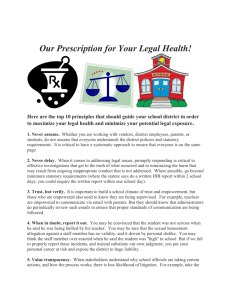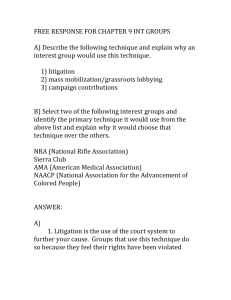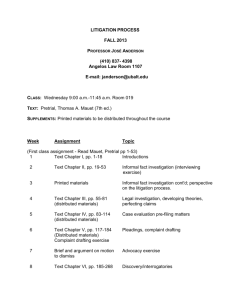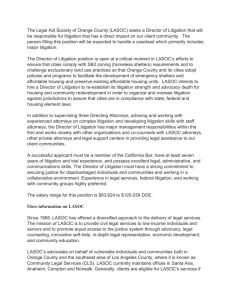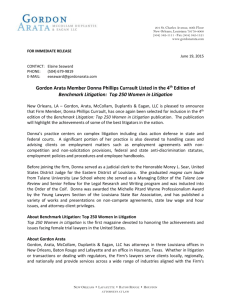Introduction
advertisement
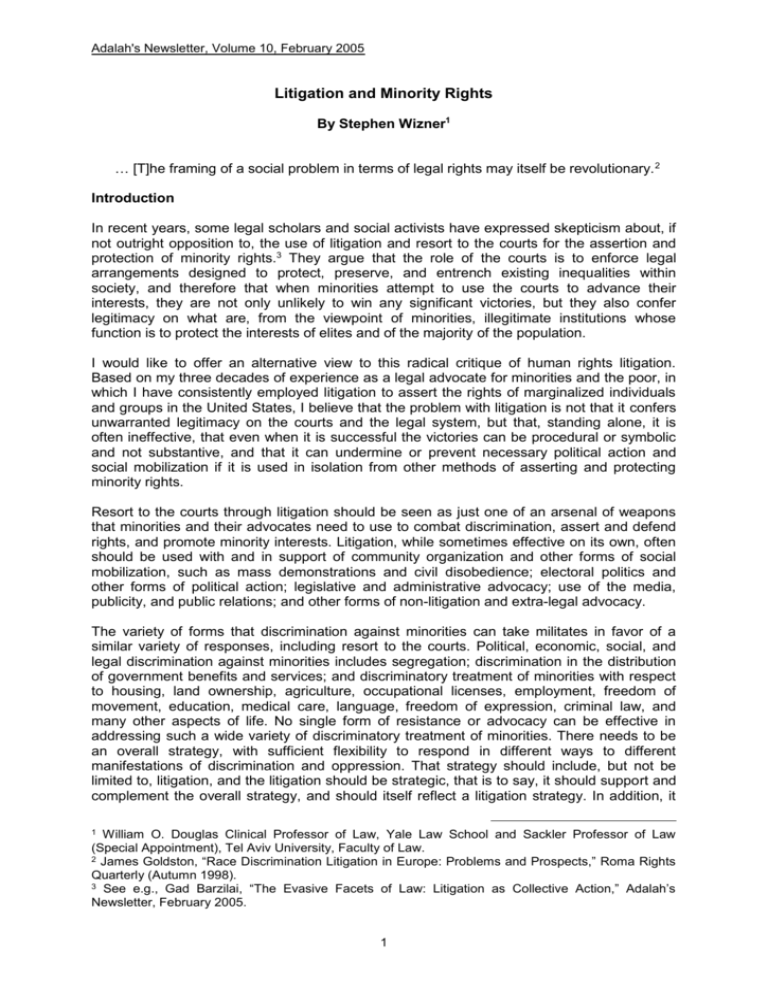
Adalah's Newsletter, Volume 10, February 2005 Litigation and Minority Rights By Stephen Wizner1 … [T]he framing of a social problem in terms of legal rights may itself be revolutionary. 2 Introduction In recent years, some legal scholars and social activists have expressed skepticism about, if not outright opposition to, the use of litigation and resort to the courts for the assertion and protection of minority rights.3 They argue that the role of the courts is to enforce legal arrangements designed to protect, preserve, and entrench existing inequalities within society, and therefore that when minorities attempt to use the courts to advance their interests, they are not only unlikely to win any significant victories, but they also confer legitimacy on what are, from the viewpoint of minorities, illegitimate institutions whose function is to protect the interests of elites and of the majority of the population. I would like to offer an alternative view to this radical critique of human rights litigation. Based on my three decades of experience as a legal advocate for minorities and the poor, in which I have consistently employed litigation to assert the rights of marginalized individuals and groups in the United States, I believe that the problem with litigation is not that it confers unwarranted legitimacy on the courts and the legal system, but that, standing alone, it is often ineffective, that even when it is successful the victories can be procedural or symbolic and not substantive, and that it can undermine or prevent necessary political action and social mobilization if it is used in isolation from other methods of asserting and protecting minority rights. Resort to the courts through litigation should be seen as just one of an arsenal of weapons that minorities and their advocates need to use to combat discrimination, assert and defend rights, and promote minority interests. Litigation, while sometimes effective on its own, often should be used with and in support of community organization and other forms of social mobilization, such as mass demonstrations and civil disobedience; electoral politics and other forms of political action; legislative and administrative advocacy; use of the media, publicity, and public relations; and other forms of non-litigation and extra-legal advocacy. The variety of forms that discrimination against minorities can take militates in favor of a similar variety of responses, including resort to the courts. Political, economic, social, and legal discrimination against minorities includes segregation; discrimination in the distribution of government benefits and services; and discriminatory treatment of minorities with respect to housing, land ownership, agriculture, occupational licenses, employment, freedom of movement, education, medical care, language, freedom of expression, criminal law, and many other aspects of life. No single form of resistance or advocacy can be effective in addressing such a wide variety of discriminatory treatment of minorities. There needs to be an overall strategy, with sufficient flexibility to respond in different ways to different manifestations of discrimination and oppression. That strategy should include, but not be limited to, litigation, and the litigation should be strategic, that is to say, it should support and complement the overall strategy, and should itself reflect a litigation strategy. In addition, it 1 William O. Douglas Clinical Professor of Law, Yale Law School and Sackler Professor of Law (Special Appointment), Tel Aviv University, Faculty of Law. 2 James Goldston, “Race Discrimination Litigation in Europe: Problems and Prospects,” Roma Rights Quarterly (Autumn 1998). 3 See e.g., Gad Barzilai, “The Evasive Facets of Law: Litigation as Collective Action,” Adalah’s Newsletter, February 2005. 1 Adalah's Newsletter, Volume 10, February 2005 should provide legal aid to individual minority group members who have personal legal problems arising out of their minority status. Litigation should be seen as only one mechanism for pursuing social justice for minorities. It should not be used if it prevents community mobilization, or if its discourse or potential results fail to reflect the values of those seeking redress. As Samera Esmeir and Rina Rosenberg have argued persuasively, resorting to law and litigation may give false hope to minorities, and may de-politicize what is fundamentally a political struggle.4 The Role of Law in Advancing Minority Rights The Civil Rights Movement for the rights of African-Americans in the United States is an example of a struggle that has employed both litigation and social action. After seven decades of enduring Jim Crow laws enacted by Southern States following the Civil War, that sanctioned segregated schools and public accommodations, denial of the right to vote, and other discriminatory treatment, in the late 1940s and early 1950s American Blacks began to challenge the injustices they faced in the courts. Lawyers for the National Association for the Advancement of Colored People (NAACP) planned and carried out a multi-year litigation strategy designed to put an end to legally sanctioned racial segregation in educational institutions. In one of the early desegregation cases, Sweatt v. Painter (1950), an African-American who wanted to attend the University of Texas Law School was denied admission solely because of his race. The State of Texas had established an all-Black law school to provide “separate but equal” legal education to non-Whites, purportedly in compliance with an earlier Supreme Court decision, Plessy v. Ferguson (1896), that had upheld racially-segregated seating in railroad cars provided that the separate accommodations were “equal” to those afforded to Whites. Sweatt’s attorneys offered proof that the Black law school was inferior to the University of Texas Law School. The U.S. Supreme Court agreed with Sweatt’s lawyers, and ordered the University of Texas to admit him. In the same year, the U.S. Supreme Court decided another case involving segregation in a public university, McLaurin v. Oklahoma (1950). The Oklahoma State University had admitted McLaurin, a Black citizen of the state, because the Black state colleges did not have comparable programs. However, the university required McLaurin to sit in isolated seats in the classrooms, library, and cafeteria, separate from the other students. McLaurin’s lawyers argued that this policy failed to provide him “equal” educational facilities, and a unanimous Supreme Court agreed. The Sweatt and McLaurin cases laid the foundation for Brown v. Board of Education (1954), in which the U.S. Supreme Court held unanimously that in public education “separate” was inherently not “equal,” and therefore that all legally-mandated public school racial segregation was unconstitutional. In its decision in Brown, the Supreme Court signaled the end of legally sanctioned segregation in the United States. But it would take years of social action, inspired by the Brown decision, to end segregation in public accommodations and the denial of voting rights to Black Americans. Inspired by the Brown decision, African-Americans, together with liberal and progressive White Americans, many of them students, exerted pressure on the legal and political system through social mobilization, mass demonstrations, civil disobedience, sit-ins, Samera Esmeir and Rina Rosenberg, “Resisting Litigation in Umm El-Fahm,” Human Rights Dialogue, Series 2, No. 2 (Spring 2000), Litigating Human Rights: Promise v. Perils, Carnegie Council on Ethics and International Affairs. 4 2 Adalah's Newsletter, Volume 10, February 2005 marches, Freedom Rides, voter registration drives, and other non-litigation and extra-legal forms of advocacy. These actions often resulted in well-publicized beatings and the imprisonment of civil rights activists, as well as urban riots and the assassinations of civil rights leaders like Martin Luther King, Jr., and of President John F. Kennedy and his brother, Attorney General Robert Kennedy, before the U.S. Congress passed the Civil Rights Acts of 1964 and 1965, outlawing racial discrimination in public accommodations, employment, and voting, and the Civil Rights Act of 1968, prohibiting racial discrimination in the sale, rental, or financing of housing. Throughout the stormy, dramatic, often violent years of the Civil Rights Movement, lawyers played an active role in support of the movement, providing legal representation to those who were arrested, filing lawsuits to enjoin public officials from interfering with or failing to provide protection for those who were asserting their rights, providing legal assistance to activists seeking law reform and social change, and bringing strategic litigation designed to implement and advance victories won in the streets and in the halls of the legislature. The Usefulness and Limitations of Litigation in Asserting Minority Rights There are important lessons to be learned from the American Civil Rights Movement about the usefulness and the limitations of litigation in asserting minority rights. Notwithstanding significant judicial and legislative victories that prohibited racial segregation in schools, government programs, public accommodations, employment and housing, and guaranteed the right of African-Americans to participate in the political process, there remains a disproportionate representation of African-Americans among the poor, the unemployed, the under-educated, and those in prison in the United States. Thus, even as we strive to expand legal protections for minorities, it is important to acknowledge that law alone is not enough to assure full equality for minorities. With that caveat in mind, it is essential to recognize that litigation does have an important role to play in advancing minority rights. Law is the basis of human rights. Human rights litigation can result in significant and lasting judicial pronouncements, especially when a court relies on constitutional provisions in rendering its decision. The decision of the U.S. Supreme Court in Brown not only established an important principle of law - that state-sanctioned racial segregation is unconstitutional - but it set the stage for the Civil Rights Movement. Thousands of American citizens, Black and White, became social activists in support of minority rights, often at considerable risk to their physical safety and economic interests, emboldened by the Supreme Court’s decision in Brown. Human rights litigation, like Brown, can serve as a means for broadening public awareness of and support for human rights for minorities, and as a catalyst for social mobilization in support of the larger struggle for equality. To play this role, human rights litigation must be strategic. It must be part of an overall strategy for advancing minority rights, and must itself be strategic in the selection of cases to bring. The goal of strategic human rights litigation in support of minority rights should be to assist in bringing about social change, by focusing on the elimination of discrimination in municipal services, public benefits and social programs, education, housing, employment, health care, and other essential aspects of life. The litigation strategy should be to employ impact litigation to generate judicial opinions that expand human rights protection for the minority group through creative legal argument and reliance on national, international, and comparative human rights jurisprudence. Another strategic goal of such litigation is to encourage interest among lawyers and legal advocacy organizations to engage in minority rights litigation, and to assist them in developing their capacity to do so. And, in addition, it is essential for minority rights groups to exploit the positive and negative results of litigation outside the courtroom, by educating the public, focusing attention on the injustice challenged 3 Adalah's Newsletter, Volume 10, February 2005 by the litigation, spurring public debate, inspiring political activity, and mobilizing support for social action. In addition to strategic impact litigation, legal advocates for minorities should handle selected individual defense cases that raise an issue of general public interest with respect to the protection of minority rights, that involve a particularly serious violation of human rights, that have the potential to have an impact on similar cases or on jurisprudence on the issue, or that can be exploited through publicity about the case to serve a wider educational and community mobilization purpose. Such a legal defense program is beyond the professional resources of an advocacy organization that focuses on strategic impact litigation. Therefore, the organization must provide training and litigation support to local lawyers in minority communities. The NAACP Legal Defense Fund has been very successful in this regard, recruiting and training local “cooperating lawyers” to handle minority rights cases on behalf of individuals. The Legal Defense Fund established a network of minority rights lawyers throughout the United States, who can handle local cases, especially high profile cases that attract attention in the media. The network of cooperating lawyers must be supported by a website, litigation manuals, legal research back-up, and a legal case archive of litigation papers, decisions, and other caserelated materials. The NAACP Legal Defense Fund has won many important victories, both in strategic impact cases and, through its network of cooperating lawyers, in individual minority rights cases. But it is crucial to view the litigation activities of the Legal Defense Fund as only one part of an overall strategy for advancing the rights of African-Americans. Even as socially committed lawyers of good will strive for social justice and social change, they must recognize that the struggle for equality extends beyond the courtroom, often to the streets. Law alone is not enough. But law can serve an important role in winning judicial pronouncements that support the claims of minorities for justice and equality, and in serving as an impetus and inspiration for social mobilization. 4
